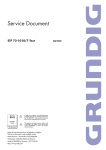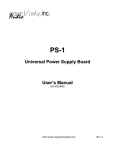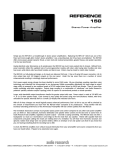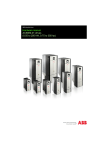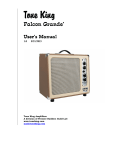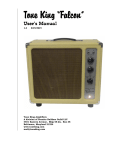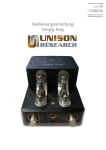Download Vista 1 User's Manual
Transcript
Mo d e l 1 Experimenter’s SE Audio Amplifier User’s Manual 500-0001MR4 http://audio.engineeringvista.com Rev. 4 Dear Customer We at ENG Vista want to take this opportunity to thank you for purchasing the Model 1 Experimenter’s SE Audio Amplifier. The people that stand behind your amplifier draw on more than a decade of professional electronics design and manufacturing experience. We are committed to providing our customers with the high quality sound at an affordable price. We have achieved this goal through modern design, quality parts, expert components sourcing and efficient manufacturing. We are confident that your amplifier will be a pleasure to experiment with and that you will gain a valuable experience. When you are ready to move to the next stage in your experimental work, the Model 1 will give you many years of listening pleasure as a part of your audio system. Before using this amplifier, please take the time to carefully read and understand the safety instructions and operating procedures. Becoming familiar with all details about your amplifier will ensure safe usage and reliable operation. Take special care when operating with high voltages and making adjustments. The effort you invest now will be well rewarded as the time goes by. THANK YOU! ENG Vista, Inc. YOUR SAFETY IS VERY IMPORTANT TO US. PLEASE READ CAREFULLY THE FOLLOWING NOTES AND SAFETY PRECAUTIONS. THANK YOU. This kit is not intended for beginners. It requires familiarity with safe procedures for tests, measurements and modifications of high voltage equipment. Exercise extreme caution when working with high voltages and always unplug the power before making any changes or adjustments. NOTE: Please make sure to check our website at http://audio.engineeringvista.com for updates, test results and latest news. On our website you can also order spare parts. Feel free to contact us with any questions or comments. We are looking forward to hearing from you. 2 SAFETY PRECAUTIONS IMPORTANT SAFEGUARDS PLEASE READ CAREFULLY ALL THE FOLLOWING IMPORTANT SAFEGUARDS THAT ARE APPLICABLE TO YOUR EQUIPMENT SAFETY 1. 2. 3. 4. 5. Read the User’s Manual and refer to it frequently during your experimenting. Retain the User’s Manual for future reference. All warnings should be strictly adhered to. Follow instructions to the last detail. This product should be operated using only the type of power source indicated in this manual. 6. Always use an electrical outlet that is grounded. If you do not know whether the outlet is grounded, consult your electrician or local power company. 7. For continued protection against fire hazard, replace fuses with the same type and rating of the fuses specified. When changing fuses, completely remove power from the circuit. 8. Power supply cords and all connecting cables or wires should be routed so that they are not likely to be walked on or pinched. Pay particular attention to cords and cables at plugs, receptacles and terminal blocks. Always use wires with adequate ratings and safety certifications (CE, UL, etc.) 9. During operation the tubes get very hot. Do not touch the tubes since this may result in a severe burn. Allow several minutes after removing power for tubes to cool down before touching them. 10. Turn off the unit as soon as you stop actively using it. Unplug the power supply from the wall during a lightning storm or when the product is to be left unattended and unused for longer periods of time. 11. Do not use this product near water or in wet areas. Damp basements should be avoided. 12. The product should be placed away from heat sources such as radiators, heaters, stoves or other appliances that produce heat. Also avoid putting the unit in the direct rays of the Sun. 13. Proper ventilation is crucial for safe and reliable operation. Never place anything on top of your amplifier that could obstruct airflow and cause the parts to overheat and damage the amplifier. Do not place your amplifier in a rack or bookcase unless proper ventilation is provided. 14. Care should be taken to prevent objects from falling and liquids from spilling into the unit. Do not subject the unit to excessive smoke, dust, vibration or shock. 15. During experimenting, make sure that all jumpers are properly seated in the correct position, that there are no foreign objects or solder bridges. 16. Always wear protective glasses and exercise caution when powering unit after any change is made. If possible, gradually rise input voltage and look for any abnormalities – smell or smoke, tubes overheating (excessive glow), etc. 3 17. Unplug this product from the wall outlet before making any changes. Wait until tubes have cooled down. 18. When using replacement parts, be sure to use parts with sufficient voltage and power rating and adequate current carrying capability. 19. Should it become necessary to replace your tubes, remove the AC power plug from the wall and allow thirty minutes for the high voltage capacitors to discharge. 20. If you have any questions regarding safe and reliable operation of your amplifier, please email us at [email protected] 4 GETTING STARTED The Model 1 amplifier kit was designed to provide: 1. a universal tube amplifier suitable for everyday listening to the music from your PC or portable music source, or as a guitar amplifier easy to overdrive; 2. a headphone amplifier; 3. an amplifier for familiarizing with the sound of Single Ended (SE) configuration; 4. a platform for experimenting with different variations of an SE topology: pentode, triode or ultralinear operation, open loop or negative feedback, parallel tubes, etc.; 5. a significant value based on a high performance to price ratio. The Model 1 is built on a two sided printed circuit board (PCB) and uses PCL82 (16A8) tubes which are specifically designed for audio applications. If you bought assembled kit rest assured that all amplifiers go through rigorous testing and extended burn-in before being shipped, so you are guaranteed to receive high quality product. There are two versions of the Model 1 amplifier kit: 1. BASIC: this amplifier will output 2-2.5W per channel in pentode mode (depending on the output transformer selected) and comes with single stereo input and one pair of tubes. It is best suited as a headphone amplifier or PC amplifier. An upgrade kit is available for conversion to the FULL-PACK version. 2. FULL PACK: this version has maximum output power of 4-5W (depending on the output transformer), has two stereo inputs and two pairs of tubes (the two tubes per channel are connected in parallel). It is best suited for listening in small rooms and as an instrument amplifier. Due to the relatively low power, the Model 1 works best with efficient speakers (SPL above 90dBm). As every other SE amplifier, the Model 1 has a low damping factor – it will perform best with single-driver Hi-Fi speakers or, alternatively, two-way speakers with simple crossovers. The standard unit is delivered as an unassembled kit or tested and burned-in basic assembly. Vacuum tubes are delivered separately in original boxes, for maximum protection. The tubes need to be inserted and firmly seated in their sockets before the power is delivered to the unit. The optimum sound reproduction will occur after 50-100 hours of operation. In normal use, upon power-up, the unit needs to warm up for about 30 minutes for maximum performance. The Model 1 kit does not include output transformers or power supply, unless it is specifically listed that it does. Output transformers and power supply are separately sold. 5 ASSEMBLING THE KIT If you purchased an unassembled kit, you will have all the parts, including tubes and printed circuit board. Parts are in marked bags, with reference numbers and value written on a bag. Reference numbers are the ones printed on the PCB, so locating parts positions should be very easy. PCB layout printout is also part of this document and you can use it to locate parts. Output transformers are purchased separately, and not included in the kit. First step is to review all the materials received, compare to the part list and prepare all tools and a well lit work area. Tools that you need are very basic – soldering iron, tweezers or flat pliers, and cutters. You will also need solder wire and a digital multimeter. If you have an oscilloscope, that will help in final testing and experiments, but it is not necessary. - Start assembly with filament configuration jumpers, configuring heaters for your specific application. - Follow with resistors, keeping in mind that resistors should be slightly elevated off the PCB (1/32” is sufficient). Main reason is that power resistors get warm and this will help air circulation and prevent overheating. Also, some resistors have circuit connections underneath and there is a possibility of malfunction if the resistor body touches exposed trace. This is not very likely, since the PCB connections are protected by a solder mask and resistors have durable coating. However, this could be a matter of safety and, also, troubleshooting of such problems is really difficult, so it is better to spend some extra time up front to come up with great assembly. - After resistors, install 2x2 headers for mode selection (Pentode, Triode, Ultralinear, FBK, etc.). - Next step is assembly of all capacitors. Make sure to follow polarity directions for electrolytic capacitors. All electrolytics have markings designating leads to be connected to the negative voltage. Model 1 printed circuit board has a plus sign for the positive terminal of an electrolytic capacitor. Positive terminal on the PCB also has a square pad around the hole, for easier identification on the bottom of the board. - After capacitors are installed you can proceed with connectors and, finally, with tube sockets and volume control potentiometers. Once everything is installed, take a short break and then come back and carefully inspect your work. Check component locations and proper orientation of electrolytic capacitors. Inspect all solder joints and make sure there are no solder bridges or splashes on the board. All joints should look clean and shiny. If you are not sure that a solder joint look right, touch it with a hot soldering iron again, until it looks right. Cold solder joints may create problems few hours (days, months) down the road and are extremely difficult to troubleshoot. Then, plug in the tubes, connect the output transformers and speakers (or dummy loads) and proceed with slowly powering up the unit. Bring the power for the filaments (Vf) first and make sure that all the tubes have about 16V on their heater pins (depending on your supply, it may take up to a minute for this voltage to stabilize). You should be able to see nice yellow/orange glow from the heaters. Tubes that you received are already burned-in, so you can continue by bringing anode voltage (Va) and measuring the most important in-circuit voltages (refer to the schematics section for test points and voltage levels). If you followed all the instructions, everything should go smoothly and now you can connect some music source to the inputs and start enjoying fruits of your hard work. But, for now, keep reading the instructions….. 6 CONNECTIONS NOTE: Before you turn the amplifier on, make sure the speaker connections are properly hooked up, or that headphone selector switch is in the headphone position. Never run the amplifier without speakers or headphones, since this may damage transformers. When turning the unit on, make sure the volume control is at its lowest setting. ELECTRICAL SCHEMATICS: The complete electrical schematics with component values is given to assist you in your experiments. Please note that the schematics is considered a copyrighted work and a trade secret. However, as a purchaser of our product you are granted a license for unlimited modifications. The only thing we ask for is that this schematics is not reprinted for public use or commercially used without getting appropriate license from ENG Vista, Inc. 7 R171 *22k/0.5W* 202-0002 All measurements at Va=250V R161 22k/0.5W 202-0002 Va J41 CONN PCB 3 1 2 OPT 3 C121 1n/500V 100-0004 PRIM RIGHT J21 *RCA-RED* 160-0001 200-0001 *100n/250V* 100-0006 C21 *100n/250V* 100-0006 95-110V 9 *1k* 200-0003 100n/250V 100-0006 9 R141 1k 200-0003 8 R51 1k 200-0003 R41 N/U 1 3 C141 470p 100-0007 J171 161-0001 1 3 1 3 V3B *PCL82* 990-0001 2 4 R211 *100R* 200-0005 R391 *1k* 200-0003 5 R231 R241 1k 1k 200-0003 200-0003 Vf1b Vf1a 6 C131 10u/350V 100-0001 7 3 R281 47R/1W 204-0001 2 4 J151 161-0001 5 Vf3b Vf3a R251 27R/2W 206-0002 16-19V 2 4 8 R91 *2k2* 200-0004 R101 2k2 200-0004 R261 27R/2W 206-0002 R282 R271 27R/2W 206-0002 47R/1W 204-0001 R151 470k 200-0007 1.20-1.45V C61 220u/35V 100-0002 R191 510R/2W 206-0001 C81 10u/350V 100-0001 SEC RIGHT 160-0004 2 4 235-249V 2 4 J121 161-0001 1 2 4 P11 50k, audio 2209-0002 R201 *1k* 200-0003 J51 CONN PCB 2 1 2 OPT UL T J141 161-0001 7 3 1 V1A PCL82 990-0001 240-245V 1 3 C51 J131 161-0001 V1B PCL82 6 990-0001 R131 100R 200-0005 R121 1k 200-0003 R61 2 4 J111 161-0001 P 1 3 R21 *1k* V3A *PCL82* 990-0001 C21a T 2 4 100n/250V 1k 100-0006 200-0001 J101 161-0001 UL 1 3 J11 RCA-RED 160-0001 C41 10u/350V 100-0001 C11 P 2 4 R11 R81 220k/0.5W 202-0001 R71 *220k/0.5W* 202-0001 C11a 100n/250V 100-0006 1 3 160-0003 C91 **220u/35V** 100-0002 C101 *10u/350V* 100-0001 R221 *510R/2W* 206-0001 J61 CONN PCB 2 1 2 SPEAKER RIGHT 160-0004 J8 3 PHONEJACK STEREO SW 5 4 2 PHONES 1 160-0005 C111 **220u/35V** 100-0002 R252 27R/2W 206-0002 R111 100R 200-0005 R262 27R/2W 206-0002 R272 27R/2W 206-0002 R181 1k FBK 1 3 200-0006 2 4 SW1 C71 J161 161-0001 1 2 3 1n/50V 100-0003 4 5 6 R172 *22k/0.5W* SW DPDT 180-0001 202-0002 R162 Va J42 CONN PCB 3 1 2 OPT 3 22k/0.5W 202-0002 C122 1n/500V 100-0004 PRIM LEFT *100n/250V* C22 100-0006 R122 1k 200-0003 9 R52 1 V2A PCL82 990-0001 100n/250V 100-0006 9 1 3 1 3 1 3 R202 *1k* 200-0003 6 J122 161-0001 R232 R242 1k 1k 200-0003 200-0003 R212 *100R* 200-0005 V4B *PCL82* 990-0001 6 J62 CONN PCB 2 1 2 SPEAKER C132 10u/350V 100-0001 7 3 2 4 5 R392 *1k* 200-0003 Vf2b Vf2a SEC LEFT 160-0004 2 4 2 4 2 4 R142 1k 200-0003 1 LEFT 160-0004 2 4 J152 161-0001 5 Vf4b Vf4a J172 161-0001 1 3 C142 470p 100-0007 V2B PCL82 990-0001 J52 CONN PCB 2 1 2 OPT T J142 161-0001 7 3 8 1k 200-0003 R42 N/U R132 100R 200-0005 C52 *1k* 200-0003 P12 50k, audio 209-0002 J132 161-0001 161-0001 2 4 R62 *100n/250V* 100-0006 J112 UL 1 3 200-0001 V4A *PCL82* 990-0001 C22a P 2 4 R22 *1k* C12 100n/250V 100-0006 T 1 3 J22 *RCA-WHITE* 160-0002 200-0001 C42 10u/350V 100-0001 UL 2 4 J12 RCA-WHITE 160-0002 R82 P 220k/0.5W 202-0001 J102 161-0001 R72 *220k/0.5W* 202-0001 C12a 100n/250V 100-0006 R12 1k 1 3 160-0003 2 4 8 R92 *2k2* 200-0004 R102 2k2 200-0004 C62 220u/35V 100-0002 R152 470k 200-0007 C82 10u/350V 100-0001 R192 510R/2W 206-0001 C92 **220u/35V** 100-0002 C102 *10u/350V* 100-0001 R222 *510R/2W* 206-0001 F10 C112 **220u/35V** 100-0002 Va 500mA 170-0001 F20 R112 100R 200-0005 Vf 3A 170-0002 R182 1k FBK 1 3 NOTES: 1. Parts with values between asterisks (*1k*, etc.) are used in the Full-Pack assembl;y; 2. C91,C92,C111 and C112 are not used. J162 161-0001 2 4 J80 CONN PCB 2 1 2 PLATE 160-0004 J90 CONN PCB 2 1 2 FILAMENT 160-0004 200-0006 C72 R290 0R N/A 1n/50V 100-0003 R300 *0R* N/A Vf1b Vf2a Vf3a Vf1a Vf2b Vf3b R310 *0R* N/A R320 *0R* N/A Vf4b Vf4a Vf R330 *0R* N/A R370 0R 8 N/A R340 *0R* N/A R350 *0R* N/A R380 0R N/A R360 *0R* N/A BOARD LAYOUT AND DIMENSIONS: The following Figure shows the component layout and dimensions of the board (in mils – 1mil=0.001inch), mounting holes and locations of tubes, potentiometers, switch and headphone connector, as well as locations of input jacks. This should help builder with designing a fitting enclosure. Please always verify dimensions by measuring the actual printed circuit board. 9 10 CONFIGURATION JUMPERS – MODE OF OPERATION: The Model 1 has four groups of jumpers intended for setting a mode of operation – Pentode mode (P), Ultralinear mode (UL) and Triode mode (T). Ultralinear mode can only be used with output transformer that have additional terminal for UL operation. Shorting blocks are inserted vertically so that the desired mode of operation is selected. The pair of pins on the far right side is not used. NOTE: At any time one of the P, UL or T connections must be used. CONFIGURATION JUMPERS – GRID BYPASS CAPACITOR: Jumper J121 (122, 151 and 152) can be used to bypass G2 on the pentode section. The bypass is preferred by some designers, it will result in slightly different sound and we decided to have it included as an option. In order to engage the bypass, the shorting block should be inserted horizontally shorting two lower pins. The upper pair of pins is not connected anywhere and can be used to hold shorting block if the bypass is not desired. NOTE: The grid bypass should only be used with Pentode mode of operation. Using it in any other mode will cause damage to the amplifier and/or output transformer! 11 CONFIGURATION JUMPERS – NEGATIVE FEEDBACK SELECTION: The Model 1 has optional negative feedback connection provided by jumper J161 (J162) – FBK. By moving the shorting block horizontally across the two lower pins, the negative feedback will be engaged. The upper two pins are shorting block holders when feedback is not engaged. By using negative feedback you will reduce the amplifier’s gain, increase bandwidth and reduce distortion. All the good stuff, but harmonic content will change, and many people do not have much respect for that kind of sound. Again, option is available, and you need to find an answer for yourself. The amount of feedback applied can be modified by changing value of R181 and R182. You will notice variations in the sound, but be careful, poorly compensated feedback will cause the amplifier to oscillate. CONFIGURATION JUMPERS – TRIODE PARALLEL CONNECTION Jumpers J171, J172 are used in the Full pack configuration to parallel cathodes of the input triodes when the bypass capacitors (C61, C62) are used. If you do not need an extra gain this capacitor provides, you can safely take it out, and then disengage J171/172 too see if you may prefer the new sound. HEATER CONFIGURATION JUMPERS: Ten zero ohm resistors R290-R380 can be used for different heater configurations. The most commonly used configurations are: - Two tubes, Basic configuration (V1 and V2), heaters in series (Vf=32V, If=0.3A): use R290, R370 and R380 - Four tubes – Full pack (V1-V4), V1 and V2 heaters in series, V3 and V4 heaters in series, the two groups of heaters connected in parallel (Vf=32V, If=0.6A): use R290, R370 and R380 (V1 and V2) and R310, R340 and R360 for V3 and V4 heaters. - ECL82 heaters (6.3V) – connect all heaters in parallel, using R290 to R360. 12 CONNECTING POWER: As any other vacuum tube amplifier, Model 1 needs two voltages for proper operation: (1) Plate, or Anode voltage, Va and (2) Heater, or filament voltage Vf. Plate voltage should be brought to the terminal block J80 and filament voltage to J90. Picture below shows the layout detail with J80 and J90. Plate voltage (Va) should have nominal value of 250V (acceptable range is 200-270V). The power source should be able to provide 80-100mA for basic configuration and 160-200mA for the full pack. Sound is significantly affected by the power supply quality, so make sure to have sufficient filtering. PCL82 tubes are designed for series connection of their filaments, so they require current source (as opposed to some other tubes that require voltage source for filament supply). Heater specification for this tube is 0.3Amp and 16V. Rugged construction of the tube’s heater allows that it is powered from the voltage source as well, but you can expect high current surge and bright yellow heater in the first few seconds of operation. In theory, this reduces life of the heater, but these tubes are very rugged and will have long life even in this less than perfect situation. Basic version of the Model 1 amplifier has the two heaters connected in series, so the filament supply needs to be able to provide 32V at 0.3A. Resistors R290-380 are placeholders for jumpers which allow for different heater configurations. ECL82 tubes (which are PCL82 equivalents with 6V heaters) can also be used, by configuring all heaters in parallel (R290 to R360 installed, R370, 380 left out). For more details refer to the description of the heater configuration jumpers, above. Filament voltage can be DC or AC, so there are no polarity markings on J90. If the DC is used, left pin is the system ground (see the Figure above), so the negative polarity of the filament voltage can be connected to that pin, although doing opposite will not affect operation, as long as filament supply is independent of plate supply. 13 CONNECTING OUTPUT TRANSFORMERS: For basic model, the output transformers should be designed to provide 5kΩ primary resistance. For the full pack, the primary resistance should have 2.5kΩ rating. Rating of the secondary winding should correspond to the impedance of your speakers (4, 8 or 16Ω, typically). There are many transformers in the market that have multiple taps to accommodate various combinations. Power rating should be minimum 3W for basic and 6W for full-pack configuration. Model 1 features two pairs of terminals for connecting output transformers. The terminals are J41 and J51 for the right channel transformer and J42, J52 for the left channel. The terminal blocks for the right channel connections are shown below. . Output transformer’s primary winding is connected to the two end terminals of J41. Right side terminal of the J41, as shown on the picture above, is connected to +Va, and the left end is connected to the plate of the pentode part of PCL82. Middle terminal is used for the ultralinear connection if the transformer has the UL tap. Left channel transformer is connected the same way using J42. Transformer’s secondary winding is connected to J51 (J52 for the left channel). Terminal with minus sign is connected to the system ground. It is important that both, left and right output transformers are connected identically, which will ensure that both channels operate in phase and provide adequate stereo picture. If the negative feedback is to be used, it is also important that the primary and secondary are connected in phase, so please carefully check transformer documentation. An oscilloscope is valuable tool if you use old, second hand transformers which may not have adequate markings. CONNECTING SPEAKERS: Speakers’ impedance should match rated secondary impedance of the output transformer. Speakers are connected to terminals J61 (right speaker) and J62 (left speaker). 14 Again, for best stereo image, they should be connected in phase. The second harmonic distortion is common with single ended amplifiers (it gives them specific, rich sound), and air transports sound with some degree of the second harmonic distortion too. It is possible to notice change in sound and reduction in distortion just by swapping plus and minus terminals, and we encourage you to experiment and find what sounds best for you. If you are swapping terminals, make sure to do it on both speakers at the same time, to preserve stereo image. CONNECTING HEADPHONES: Headphone output is not a typical feature of a tube amplifier. There are technical and commercial reasons (it increases manufacturer’s cost). We wanted to make sure that Model 1 can be used as a headphone amplifier too, so the output is there. We were able to take advantage of the amplifier’s relatively low output power and came up with a clever way to have the amplifier work at normal power levels with headphones (Watts instead of milli Watts) and even to push the amplifier to clipping, if needed. Connecting headphones is fairly straightforward: use standard 3.5mm headphone connector J8 and flip the switch SW1. SW1 will engage dummy load across the output transformers and bring signal to the headphones. We believe that this is the best way to preserve the original sound of the amplifier when headphones are used. With headphones (which are typically very low power devices) the amplifier will operate properly loaded up to maximum output, and you can even enjoy the specific sound of tubes’ soft clipping, if you desire (this may be very interesting if you intend to use the Model 1 as a guitar amplifier and not disturb anybody). Dynamic headphones come in several nominal impedances – 16 to 600 Ω and you may notice that the maximum sound level is too high or too low. You can adapt the Model 1 amplifier to your headphones by changing resistors R281 and R282. The resistors are in series with the headphones, and by increasing their value you will increase attenuation. VOLUME CONTROL AND AUDIO INPUTS: Less expensive stereo potentiometers have poor symmetry between the two parts and we did not want to burden the product with expensive ones, so we went with separate volume controls for the left and right channel. One pair of analog inputs is installed as a standard feature and there is a place for another pair of inputs, if you need to connect more than one source. The input selector is not required, since the source that is not used will not affect the active one. If you have both sources working at the same time, you will hear a strange mix of the two inputs. The gain of the amplifier will change, depending on whether or not you decide to use the negative feedback . Gain is significantly higher without feedback, so you will not need to turn the volume knob that far to get to clipping. With the feedback engaged (you can do it by moving jumpers on J161, J162 one position down) the gain will drop significantly, and the volume knob will have to travel further for the same output power. 15 UPSIDE - DOWN ASSEMBLY The Model 1 printed circuit board (PCB) was designed with top to bottom symmetry. This symmetry enables building a tube amplifier with “tube audio look”, where tubes are mounted on top of the chassis. All parts, except tube sockets, can be mounted on the bottom of the board and soldered on the top side (top side is the one with component references in white silkscreen). That way, the PCB can be mounted close to the top of the chassis and tube sockets can be flush with the top, or even slightly higher, depending on your preferences. There are few things to keep in mind though: - Top of the PCB should be at least ¼” below the chassis, to prevent metal chassis from shorting PCB circuits. - PCB has a 1/8” hole underneath the sockets. Make sure to provide support to the PCB using the holes (in addition to the five mounting holes), to prevent board flexing and possible damage to the PCB when tubes are inserted or removed. - You may find it convenient to use chassis mounted sockets, in which case there is no stress on the PCB during tubes insertion/removal. From the chassis mounted socket you can “drop” wires to the PCB. Be sure to use short insulated wires. - If you mount headphones connector to the bottom of the board, left and right channel will swap. To bring everything back in order, you will need to swap inputs. Then your speakers will have left and right channel swapped. To rectify that, you will need to connect left speaker to the right channel and vice versa. Or, you can simply use a chassis mounted headphone jack and connect wires to the PCB in the right order. - When the headphones/speakers selector switch is moved to the bottom, it will reverse the function – headphones position will turn the speakers on and vice versa. We do not think this is a major issue but you should be aware. - If you move volume control potentiometers to the bottom of the PCB, the minimum volume position will become maximum. It may be cool, but it could also be annoying. The only solution to the problem is to use chassis mounted potentiometers and bring wires to the PCB. - If you use chassis mounted parts (input jacks, headphone connector, switch and volume control, make sure to use short coaxial cables to minimize noise pickup and stray capacitances that may cause amplifier to oscillate. 16 FINAL WORDS Once again, thank you for your purchase. We hope that the Model 1 will give you hours and hours of fun and have you experience a multitude of different qualities of the “tube sound”. Once you have exhausted all of the options, we hope that you will “retire” the amplifier from your bench into a nice chassis and have it rest on your work desk or in the bedroom accompanied by a PC or an MP3 player of some kind. Once all experiments are finished, make sure to permanently short selected jumpers (one way is to bend the pins and solder them together) in order to prevent deterioration of contacts over time. Robust design should provide you with years of pleasant sounds, with only maintenance being change of tubes, once the original ones are too weak to rumble. Our design is really gentle with the tubes, so they should last much longer than tubes in some other designs that try to pull the last milliWatt out of them. Finally, we want to remind you once again to take extreme caution while working with high voltages. If you are not thoroughly familiar with the safety procedures, feel free to enlist help of a relative or friend. There are many very knowledgeable people in this field and they all share passion for spreading the art and science of high quality sound reproduction. Copyright, ENG Vista, Inc. 2007 17 PARTS LIST Parts with asterisks in the VALUE column are used in the Full-Pack assembly. Item 1 Reference Qty EPN 2 R41, R42 R11, R12, R51, R52, R121, R122, R141, R142, R181, R182, R231, R232, R241, R242 200-0003 R21, R22, R61, R62, R201, R202, R391, R392 200-0003 R71, R72 202-0001 R81, R82 202-0001 R91, R92 200-0004 R101, R102 200-0004 R111, R112, R131, R132 200-0005 R151, R152 200-0007 R161, R162 202-0002 R171, R172 202-0002 R191, R192 206-0001 R211, R212 200-0005 R221, R222 206-0001 Value N/U 2 14 3 4 5 6 7 8 9 10 11 12 13 14 8 2 2 2 2 4 2 2 2 2 2 2 15 16 17 27R/2W 39R/1W 0R 22 6 R251, R252, R261, R262, R271, R272206-0002 2 R281, R282 204-0002 3 R290, R370, R380 N/A R300, R310, R320, R330, R340, R350, 7 R360 N/A 1 F10 170-0001 1 F20 170-0002 J101, J102, J111, J112, J121, J122, 8 J161, J162 161-0001 J131, J132, J141, J142, J151, J152, 8 J171, J172 161-0001 23 6 @J101, J102, J121, J122, J161, J162 161-0002 SHORTING BLOCK, 0.1" 24 25 26 27 28 29 30 31 32 33 34 35 36 37 38 39 40 41 42 43 44 45 46 47 48 6 2 6 6 4 6 2 2 2 4 2 2 1 1 1 1 1 2 1 2 2 2 2 1 1 18 19 20 21 @J131, J132, J151, J152, J171, J172 161-0002 J41, J42 160-0003 J51, J52, J61, J62, J80, J90 160-0004 C11, C11a, C12, C12a, C51, C52 100-0006 C21, C21a, C22, C22a 100-0006 C41, C42, C81, C82, C131, C132 100-0001 C61, C62 100-0002 C71, C72 100-0003 C101, C102 100-0001 C91, C92, C111, C112 100-0002 C121, C122 100-0004 C141, C142 100-0007 J8 160-0005 J11 160-0001 J12 160-0002 J21 160-0001 J22 160-0002 P11, P12 209-0002 SW1 180-0001 @V1, V2 990-0002 @V3, V4 990-0002 V1, V2 990-0001 V3, V4 990-0001 PCB 500-0001 User Manual 500-0001 1k *1k* *220k/0.5W* 220k/0.5W *2k2* 2k2 100R 470k 22k/0.5W *22k/0.5W* 510R/2W *100R* *510R/2W* *0R* 500mA 3A JUMPER 2X2 *JUMPER 2X2* *SHORTING BLOCK, 0.1"* CONN PCB 3 CONN PCB 2 100n/250V *100n/250V* 10u/350V 220u/35V 1n/50V *10u/350V* **220u/35V** - NOT USED 1n/500V 470p/50V PHONEJACK STEREO SW RCA-RED RCA-WHITE *RCA-RED* *RCA-WHITE* 50k, audio SW DPDT 9-PIN MINI SOCKET *9-PIN MINI SOCKET* PCL82 *PCL82* PCB User Manual 18


















